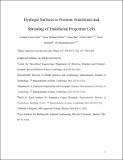| dc.contributor.author | Camci-Unal, Gulden | |
| dc.contributor.author | Nichol, Jason W. | |
| dc.contributor.author | Bae, Hojae | |
| dc.contributor.author | Tekin, Halil | |
| dc.contributor.author | Bischoff, Joyce | |
| dc.contributor.author | Khademhosseini, Ali | |
| dc.date.accessioned | 2014-07-01T16:34:23Z | |
| dc.date.available | 2014-07-01T16:34:23Z | |
| dc.date.issued | 2013-05 | |
| dc.date.submitted | 2011-07 | |
| dc.identifier.issn | 19326254 | |
| dc.identifier.issn | 1932-7005 | |
| dc.identifier.uri | http://hdl.handle.net/1721.1/88166 | |
| dc.description.abstract | Endothelialization of artificial vascular grafts is a challenging process in cardiovascular tissue engineering. Functionalized biomaterials could be promising candidates to promote endothelialization in repair of cardiovascular injuries. The purpose of this study was to synthesize hyaluronic acid (HA) and heparin-based hydrogels that could promote adhesion and spreading of endothelial progenitor cells (EPCs). We report that the addition of heparin into HA-based hydrogels provides an attractive surface for EPCs promoting spreading and the formation of an endothelial monolayer on the hydrogel surface. To increase EPC adhesion and spreading, we covalently immobilized CD34 antibody (Ab) on HA–heparin hydrogels, using standard EDC/NHS amine-coupling strategies. We found that EPC adhesion and spreading on CD34 Ab-immobilized HA–heparin hydrogels was significantly higher than their non-modified analogues. Once adhered, EPCs spread and formed an endothelial layer on both non-modified and CD34 Ab-modified HA–heparin hydrogels after 3 days of culture. We did not observe significant adhesion and spreading when heparin was not included in the control hydrogels. In addition to EPCs, we also used human umbilical cord vein endothelial cells (HUVECs), which adhered and spread on HA–heparin hydrogels. Macrophages exhibited significantly less adhesion compared to EPCs on the same hydrogels. This composite material could possibly be used to develop surface coatings for artificial cardiovascular implants, due to its specificity for EPC and endothelial cells on an otherwise non-thrombogenic surface. | en_US |
| dc.description.sponsorship | National Institutes of Health (U.S.) (Grant EB008392) | en_US |
| dc.description.sponsorship | National Institutes of Health (U.S.) (Grant DE019024) | en_US |
| dc.description.sponsorship | National Institutes of Health (U.S.) (Grant HL092836) | en_US |
| dc.description.sponsorship | National Institutes of Health (U.S.) (Grant HL099073) | en_US |
| dc.description.sponsorship | National Institutes of Health (U.S.) (Grant AR057837) | en_US |
| dc.description.sponsorship | United States. Army Research Office. Institute for Soldier Nanotechnologies | en_US |
| dc.description.sponsorship | United States. Army. Corps of Engineers | en_US |
| dc.description.sponsorship | National Science Foundation (U.S.) (Grant No. DMR0847287) | en_US |
| dc.language.iso | en_US | |
| dc.publisher | John Wiley & Sons, Inc | en_US |
| dc.relation.isversionof | http://dx.doi.org/10.1002/term.517 | en_US |
| dc.rights | Article is made available in accordance with the publisher's policy and may be subject to US copyright law. Please refer to the publisher's site for terms of use. | en_US |
| dc.source | Ali Khademhosseini | en_US |
| dc.title | Hydrogel surfaces to promote attachment and spreading of endothelial progenitor cells | en_US |
| dc.type | Article | en_US |
| dc.identifier.citation | Camci-Unal, Gulden, Jason William Nichol, Hojae Bae, Halil Tekin, Joyce Bischoff, and Ali Khademhosseini. “Hydrogel Surfaces to Promote Attachment and Spreading of Endothelial Progenitor Cells.” Journal of Tissue Engineering and Regenerative Medicine 7, no. 5 (May 2013): 337–347. | en_US |
| dc.contributor.department | Harvard University--MIT Division of Health Sciences and Technology | en_US |
| dc.contributor.department | Massachusetts Institute of Technology. Department of Electrical Engineering and Computer Science | en_US |
| dc.contributor.department | McGovern Institute for Brain Research at MIT | en_US |
| dc.contributor.department | Koch Institute for Integrative Cancer Research at MIT | en_US |
| dc.contributor.mitauthor | Camci-Unal, Gulden | en_US |
| dc.contributor.mitauthor | Nichol, Jason W. | en_US |
| dc.contributor.mitauthor | Bae, Hojae | en_US |
| dc.contributor.mitauthor | Tekin, Halil | en_US |
| dc.contributor.mitauthor | Khademhosseini, Ali | en_US |
| dc.relation.journal | Journal of Tissue Engineering and Regenerative Medicine | en_US |
| dc.eprint.version | Author's final manuscript | en_US |
| dc.type.uri | http://purl.org/eprint/type/JournalArticle | en_US |
| eprint.status | http://purl.org/eprint/status/PeerReviewed | en_US |
| dspace.orderedauthors | Camci-Unal, Gulden; Nichol, Jason William; Bae, Hojae; Tekin, Halil; Bischoff, Joyce; Khademhosseini, Ali | en_US |
| dspace.mitauthor.error | true | |
| mit.license | PUBLISHER_POLICY | en_US |
| mit.metadata.status | Complete | |
